bol
Active Member
For the new year I decided to get into all grain brewing. I had done a kit beer awhile back and I found the kit process to be less than entertaining, the equivalent of dumping a bag of concentrated wort into a bucket. A good friend of mine does all grain brewing and after sitting in on a brew day with him I decided that it was time to get into it myself. I jumped right into all grain because I am a perfectionist dork and wanted to know exactly what was going in my beer and have control over every step.
For my first brew I decided to use one of the brown ales in Papazian's book.
Prep
The night prior I used my friends corona mill to crush my grains and after 30 minutes of using the hand crank I know I will appreciate my motorized barley crusher when it arrives this week! I had thoroughly cleaned all of my equipment the week earlier with Diversol so this time around I prepared an iodaphor solution to sanitize all of my equipment and filled a spray bottle with the solution to do any spot sanitization as I worked post boil.
The Mash
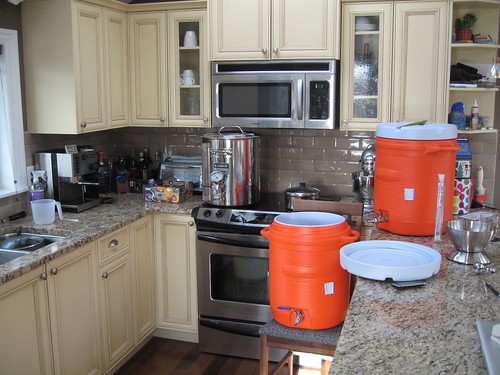
I preheated my tun, a 10 gal rubbermaid cooler w/stainless false bottom using some hot water while I waited for my strike water to heat up on the stove. My electric range took about 30 minutes to heat up the 3 gal's of strike water to 168F. Next time I'll have to use the propane burner.
I doughed in, mixed well and took a temperature reading - exactly 152F.
The Sparge
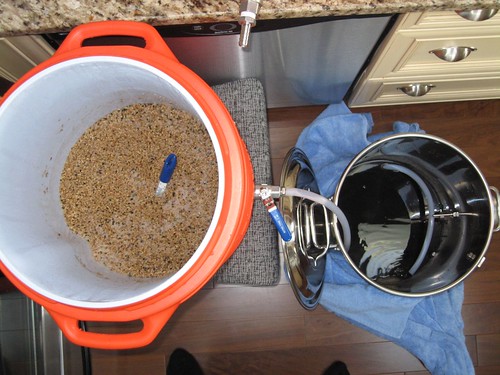
About 20minutes before the end of the mash I heated up my sparge water using the propane burner which took significantly less time. I heated the 5.5 gals of sparge water up to about 180F, expecting that heat loss to my HLT (another 10gal rubbermaid cooler) would bring it down closer to 170F which it did. Next time I might want to get it hotter, I found during the sparge that the grain bed only got about to ~168F.
I drained the tun and I had to vorlauf about 3 quarts before the running were clear. I added half of my sparge water, stirred well and waited 15 minutes before sparging again. This time after ~2 quarts the running's were clear. I added the remaining sparge water, stirring well again and waiting an additional fifteen minutes. This time I only had to vorlauf once.
All said and done I collected 6.75 G of wort. I took a gravity reading - 1.045 which I thought was quite high. More on that later.
The Boil
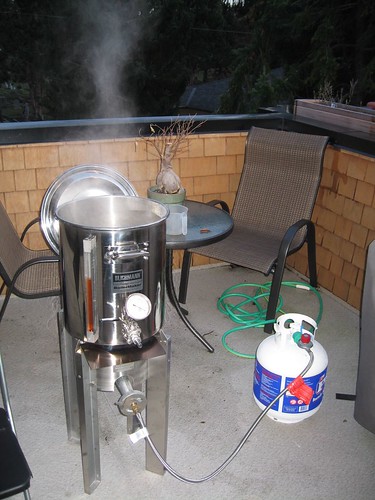
I carried the kettle out to the burner and fired it up. It didn't take long for the banjo burner to bring the wort to a boil. I added my boiling hops and set my timer.
As the boil neared the 50 minute mark I noticed that there was still about 5.75 gallons left, according to the sight gauge. I decided to wait another 10 minutes before adding my aroma hops. After a 70 minute boil I turned off the burner and realized I forgot to add my irish moss. I added the irish moss anyways and whirlpooled to help collect any trub in the center of the kettle, closed the lid and waited 15 minutes. Total volume by the sight gauge was just over 5 gallons.
The Chill
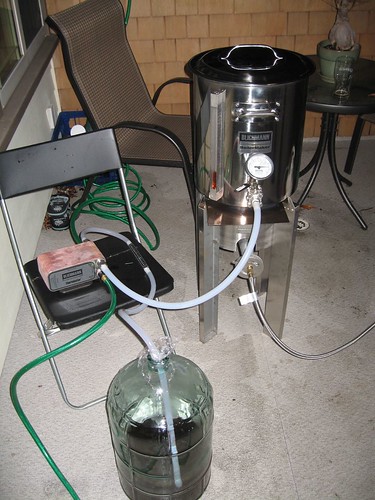
While I waited for the 15minutes to be up I hooked up my plate chiller, a Therminator and got ready to drain into my carboy. The Therminator worked incredibly well and I actually had to reduce the water flow significantly as the temperature of the cooled wort was starting to get below 60F and I didn't want to wait for the wort to warm back up again to pitch my yeast. Frost was actually starting to develop on the chiller(8C/46F outside.) The Thrumometer was useful in gauging the wort temperature.
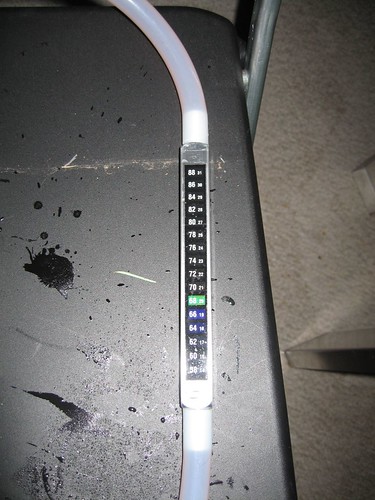
Very little wort was left over in the kettle and the 'old' Blichmann kettle strainer worked just fine with the 1 oz of hops that I didn't put into a nylon bag. Next time I won't even bother bagging my hops.
Aerate and Pitch
I used a wine aerator attached to a drill to help aerate my wort, which creates an huge whirl pool and after changing directions a few times and running it for about a minute I figured it had enough. I didn't want to rock the carboy back and forth on the floor - the fewer times I have to lift and move around 5 gallons of liquid the better.
The OG reading was 1.065, much higher than the target 1.048 and 1.052. I decided to add some cold water to compensate but after adding a quart I decided it wasn't worth messing with and risking the batch.
I pitched my yeast, a Wyest 1056 American Ale which was smacked 4 hours earlier and well expanded, tucked the carboy away in its closet with a blow off tube. There were signs of fermentation within 3 hours.
Happily fermenting ~ 30 hours later.
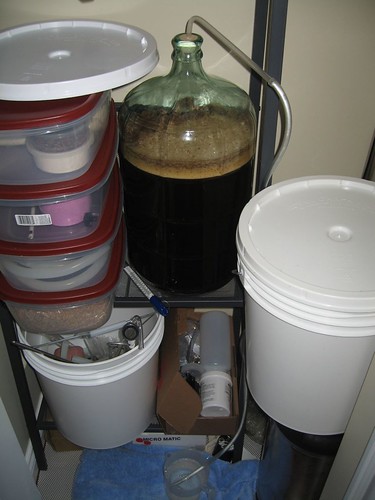
The Mistakes
I'm Canadian and am used to the metric system. I almost never deal in us or imperial units. Almost everything in brewing is in lbs/oz so rather than converting everything to the units I am most familiar with I just left them as is. I didn't think I'd do anything silly but I ended up mis-measuring my grain as a result. I got caught thinking in imperial units rather than US units and as a result measured my grains wrong (thought there was 20 oz in a lb instead of 16 oz in a lb.) That meant for all of my grain's that weren't whole lb's I ended up with an extra 2 oz each which got me an extra half pound of grain. Not a big deal all in all but likely why my OG ended up at 1.065.
Additionally I measured the potential gravity of my grain bill and worked out my efficiency to be at 83% where I suspect the original recipe assumed somewhere in the 70% range. Not a bad problem to have.
Conclusion
All in all a great brew day and I can't wait to taste the brew when it's ready in a few weeks! I need to buy some more corny kegs and a couple more carboys so I can get several on the go
For my first brew I decided to use one of the brown ales in Papazian's book.
Prep
The night prior I used my friends corona mill to crush my grains and after 30 minutes of using the hand crank I know I will appreciate my motorized barley crusher when it arrives this week! I had thoroughly cleaned all of my equipment the week earlier with Diversol so this time around I prepared an iodaphor solution to sanitize all of my equipment and filled a spray bottle with the solution to do any spot sanitization as I worked post boil.
The Mash

I preheated my tun, a 10 gal rubbermaid cooler w/stainless false bottom using some hot water while I waited for my strike water to heat up on the stove. My electric range took about 30 minutes to heat up the 3 gal's of strike water to 168F. Next time I'll have to use the propane burner.
I doughed in, mixed well and took a temperature reading - exactly 152F.
The Sparge

About 20minutes before the end of the mash I heated up my sparge water using the propane burner which took significantly less time. I heated the 5.5 gals of sparge water up to about 180F, expecting that heat loss to my HLT (another 10gal rubbermaid cooler) would bring it down closer to 170F which it did. Next time I might want to get it hotter, I found during the sparge that the grain bed only got about to ~168F.
I drained the tun and I had to vorlauf about 3 quarts before the running were clear. I added half of my sparge water, stirred well and waited 15 minutes before sparging again. This time after ~2 quarts the running's were clear. I added the remaining sparge water, stirring well again and waiting an additional fifteen minutes. This time I only had to vorlauf once.
All said and done I collected 6.75 G of wort. I took a gravity reading - 1.045 which I thought was quite high. More on that later.
The Boil

I carried the kettle out to the burner and fired it up. It didn't take long for the banjo burner to bring the wort to a boil. I added my boiling hops and set my timer.
As the boil neared the 50 minute mark I noticed that there was still about 5.75 gallons left, according to the sight gauge. I decided to wait another 10 minutes before adding my aroma hops. After a 70 minute boil I turned off the burner and realized I forgot to add my irish moss. I added the irish moss anyways and whirlpooled to help collect any trub in the center of the kettle, closed the lid and waited 15 minutes. Total volume by the sight gauge was just over 5 gallons.
The Chill

While I waited for the 15minutes to be up I hooked up my plate chiller, a Therminator and got ready to drain into my carboy. The Therminator worked incredibly well and I actually had to reduce the water flow significantly as the temperature of the cooled wort was starting to get below 60F and I didn't want to wait for the wort to warm back up again to pitch my yeast. Frost was actually starting to develop on the chiller(8C/46F outside.) The Thrumometer was useful in gauging the wort temperature.

Very little wort was left over in the kettle and the 'old' Blichmann kettle strainer worked just fine with the 1 oz of hops that I didn't put into a nylon bag. Next time I won't even bother bagging my hops.
Aerate and Pitch
I used a wine aerator attached to a drill to help aerate my wort, which creates an huge whirl pool and after changing directions a few times and running it for about a minute I figured it had enough. I didn't want to rock the carboy back and forth on the floor - the fewer times I have to lift and move around 5 gallons of liquid the better.
The OG reading was 1.065, much higher than the target 1.048 and 1.052. I decided to add some cold water to compensate but after adding a quart I decided it wasn't worth messing with and risking the batch.
I pitched my yeast, a Wyest 1056 American Ale which was smacked 4 hours earlier and well expanded, tucked the carboy away in its closet with a blow off tube. There were signs of fermentation within 3 hours.
Happily fermenting ~ 30 hours later.

The Mistakes
I'm Canadian and am used to the metric system. I almost never deal in us or imperial units. Almost everything in brewing is in lbs/oz so rather than converting everything to the units I am most familiar with I just left them as is. I didn't think I'd do anything silly but I ended up mis-measuring my grain as a result. I got caught thinking in imperial units rather than US units and as a result measured my grains wrong (thought there was 20 oz in a lb instead of 16 oz in a lb.) That meant for all of my grain's that weren't whole lb's I ended up with an extra 2 oz each which got me an extra half pound of grain. Not a big deal all in all but likely why my OG ended up at 1.065.
Additionally I measured the potential gravity of my grain bill and worked out my efficiency to be at 83% where I suspect the original recipe assumed somewhere in the 70% range. Not a bad problem to have.
Conclusion
All in all a great brew day and I can't wait to taste the brew when it's ready in a few weeks! I need to buy some more corny kegs and a couple more carboys so I can get several on the go


